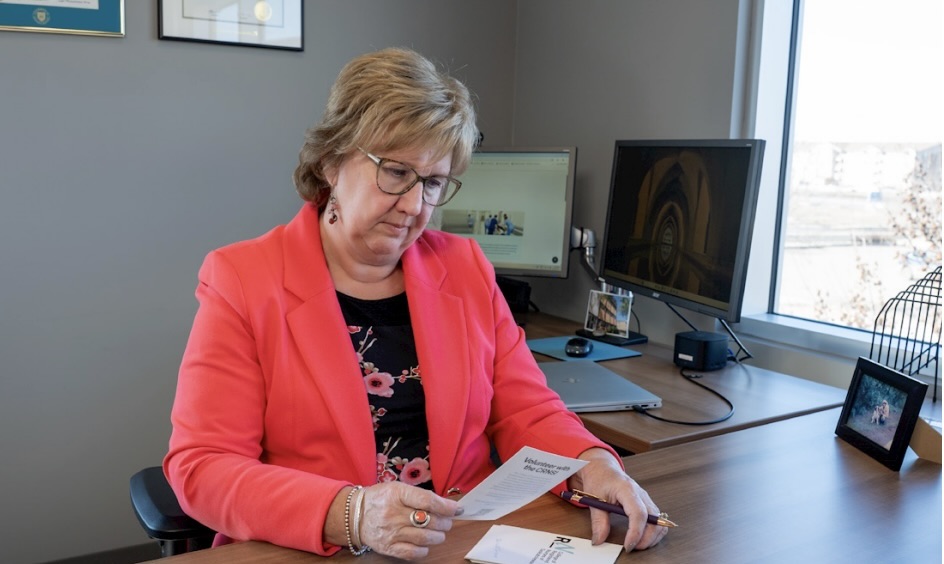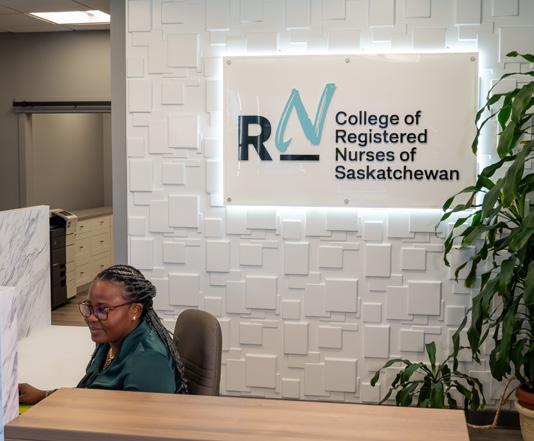
8 minute read
CARE BEYOND THE STATUS QUO
Cindy Smith’s vision for modern nursing regulation in Saskatchewan
The Registrar staff
Cindy Smith has always viewed leadership in nursing as more than a principle to follow. It’s a call to action that demands a deep commitment to public protection.
As executive director and registrar at the College of Registered Nurses of Saskatchewan (CRNS), Smith draws on decades of nursing experience to explain that leading change and staying at the forefront of nursing regulation must be grounded in basic humanity.
“I’ve been a nurse, and I know what it’s like to be in the thick of it, to feel stretched thin, to wonder if you’re making a difference,” Smith says. “That perspective never leaves me. It guides every decision I make. This work is about care, and if [nursing] regulators forget to bring that same care into our work, then we’re failing the very profession we serve.”
Career milestones rooted in health-care leadership
Smith began her career as a front-line nurse and quickly recognized how leadership could shape health care delivery. Over the years, she moved through various administrative and policy roles, honing her skills in governance, regulatory affairs, and system-wide health-care improvements. After obtaining her master of nursing degree at Athabasca University, she spent time as an associate dean at Saskatchewan Polytechnic, further deepening her expertise in high-level decision-making.
“I never set out to be a regulator,” she reflects. “I knew I wanted to be in a position where I could make a meaningful impact not just for nurses, but for the communities they care for. Nursing has always been about service, and I came to see [professional] regulation as an extension of that service.”
Challenging nursing regulation's status quo
Smith’s appointment as CRNS executive director and registrar in January 2019 marked a pivotal moment for both her career and the organization’s status quo. She took on the monumental task of guiding the College as the organization separated its regulatory responsibilities from its former advocacy functions. Smith embraced the challenge with a clear vision and says it allowed CRNS to fully commit to an enhanced regulatory mandate.
“Change is never easy, and this transition was no exception,” she reflects. “But, at the heart of it, we had to ask ourselves, ‘What is our primary role?’ The answer was clear: protecting the public through effective regulation.”
“The shift allowed us to strengthen our regulatory role, improve transparency, and build public trust,” Smith says. “It also ensured nurses are held to the highest professional standards and created space for others to advocate for the profession. Regulation and advocacy are both critical, but they serve different purposes. Our responsibility is public protection, and that must remain our singular focus,” she says, reiterating CRNS’s commitment to public protection.
Under Smith’s leadership, CRNS has continued to take bold steps to modernize its regulatory framework since divestment, while ensuring the public’s trust remains at the core of its mission.
This progressive approach has led to governance reforms, increased transparency, and a commitment to evidence-based decision-making through collaboration with government, health-care leaders, and the public.
As part of this work, Smith has contributed to advancing streamlined licensure recognition across provinces to help reduce barriers for nurses moving between jurisdictions. Provincially, CRNS is an active member of the Saskatchewan Public Regulatory Advisory Network (SPRAN), a collective of health regulators working together to align regulatory practices and strengthen public protection. CRNS also partners with other nursing regulators across Canada to support consistency in licensure mobility, workforce planning, and regulatory best practices. “At the end of the day, regulation should facilitate safe and effective practice, not create unnecessary hurdles,” she emphasizes. “We need to ask ourselves: are we making this easier or harder for nurses to provide quality care?”
“Nurses move across provinces, and our frameworks need to reflect that reality,” Smith affirms. “Through constant engagement, we can create a progressive system that is rigorous in public protection, and supportive of the nursing workforce. No nurse should have to jump through unnecessary hoops just because they’re moving from one province to another.”
Nursing in the artificial intelligence era
One area where Smith sees enormous potential is the use of artificial intelligence in nursing regulation. As AI-driven tools become more integrated into health care, CRNS is exploring how it can enhance regulatory processes, from credential verification to identifying patterns in professional conduct cases. She also envisions AI being used to automate parts of the licensure process, reducing wait times for applicants while maintaining stringent, human-based regulatory oversight.
“AI shouldn’t be seen as a replacement for the human element of regulation, but rather as an enhancement,” she explains. “We’re exploring how data-driven insights can help us predict risks before they become issues, and how we can use technology to streamline processes for nurses and the public.”
“Imagine a system where licensing applications are processed in days instead of weeks, or where early warning signs in practice trends help us intervene before a crisis occurs,” Smith says. “That’s the future we need to build, and we need to explore the potential of every tool available to make fair, efficient, and transparent decisions. We can’t regulate today’s nurses with yesterday’s policies. Health care is evolving rapidly, and nursing regulation must keep pace because we risk failing the very people we are here to protect if we aren’t adaptive.”
Reinforcing a strong workforce
Recent data from the Canadian Institute for Health Information (CIHI) shows that Saskatchewan is leading Western Canada in health-care staffing efforts. Smith attributes this to the importance of inclusivity, which ensures diverse voices in the nursing profession and from the public are heard. “We regulate in the public interest, which means our policies must reflect the needs and expectations of the people we serve,” she says. “Our workforce is dependent on nurses from all backgrounds, with different experiences and perspectives. That’s how we build a stronger, more resilient health-care system.”

One of Smith’s most notable initiatives as executive director and registrar has been improving pathways for internationally educated nurses (IENs) to join Saskatchewan’s health-care workforce. Recognizing the urgent need for skilled nurses, CRNS has worked closely with the provincial government, employers, and educators to simplify and accelerate licensing processes while maintaining high regulatory standards.
“We have incredible talent coming from around the world,” Smith says. “Our role is to provide the right supports and assessments to help them succeed in our health care system.”
CRNS emphasizes Saskatchewan Polytechnic’s transition program, a collaborative effort with the National Nursing Assessment Service (NNAS), CRNS, and employers designed to help IENs integrate smoothly by providing them with mentorship and resources to meet Saskatchewan’s practice standards. The college also implemented centralized assessment processes with NNAS to reduce duplication and improve the speed at which internationally trained nurses can enter the workforce. “We need these professionals in our health-care system, and we need them now,” Smith states. “If we don’t act quickly, we risk losing skilled nurses to other jurisdictions. Saskatchewan should be a place where nurses want to come, stay, and thrive.”

It's why CRNS was recently recognized as a Top Employer for 2025, a distinction that Smith says represents the college’s push for innovation and professional growth. She credits CRNS staff and the supportive and inclusive workplace culture for creating the work environment that makes innovation possible. “In five years, I want us to be known not just for enforcing standards, but for innovating them,” she says. “Regulation shouldn’t be about maintaining the status quo, but rather, be about pushing the profession forward in a way that ultimately benefits patients.”
Embodying leadership
Smith envisions future regulatory frameworks to be even more proactive, adaptable, and responsive to the evolving health-care landscape. CRNS is positioned as a leader in shaping the future of health-care regulation, she says, and the college will continue to provide guidance on key regulatory touchpoints, such as workforce shortages and optimizing the scope of practice for nursing professionals.
While divestment marked a pivotal shift for the college, Smith foresees a greater role for regulators in advocating for policy changes that support the nursing profession. “Regulation and advocacy don’t have to be at odds,” she says. “We can champion policy improvements that benefit both nurses and the public while staying true to our regulatory mandate.”
Smith’s regulatory leadership is defined by a rare combination of pragmatism and vision; a perspective she says was heavily inspired by American leadership scholar Barry Posner.
“One of the things I admire about Posner’s work is the idea that leaders have to ‘model the way,’ and that you can’t just set expectations,” she says. “You must embody them. In regulation, that means leading with transparency, accountability, and a commitment to the public good.”
“Everything we do comes back to the public,” she concludes. “Great leaders aren’t afraid to challenge the process, and that’s something I’ve taken to heart. The best way to serve the nursing profession isn’t to preserve the status quo, but rather, to push boundaries and rethink what’s possible.”

